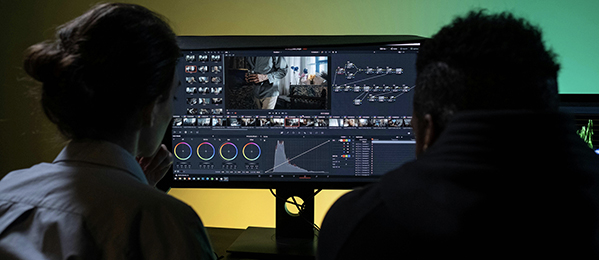
The Attention Economy: How Event Spaces are Becoming Media Companies
In a surgical demonstration at the OLC last year, something remarkable happened that would have been unthinkable five years ago. As a renowned orthopedic surgeon demonstrated a novel knee replacement technique, three distinct audiences watched intently: 24 surgeons stationed at bio-skills stations in the room, 150 medical professionals across North America via live stream, and thousands more who would access the recorded procedure in the following weeks.
This wasn’t just a training session—it was a multi-platform media event.
Built for Broadcast: Venues Offer More Than Space
The transformation has been swift and profound. Across the country, major conference destinations are reinventing themselves as media production centers. In Las Vegas, a purpose-built hybrid event studio spanning 25,000 square feet now accommodates up to 250,000 virtual participants with a 360-degree 4K LED stage and sophisticated real-time interaction tools. Similar venues increasingly offer integrated digital capabilities.
But the most significant shift isn’t just technological—it’s conceptual. Content creation spaces have become central to modern venue design, from podcast booths to fully equipped video studios that transform presentations into polished media productions.
The OLC stands at the forefront of this evolution. What was once a traditional meeting and training facility has transformed into a sophisticated media production hub. When medical associations, corporate clients, and professional organizations book the OLC today, they’re not just renting space—they’re accessing a complete broadcast ecosystem designed to capture, enhance, and distribute valuable content to audiences both in the room and around the world.
“We’ve essentially become media producers for our clients,” explains Lisé Puckorius, CEO of the OLC. The numbers validate this shift. The OLC has seen a significant increase in clients utilizing its advanced media capabilities since 2023, with organizations across medical, corporate, and educational sectors leading the trend. Groups that previously focused solely on in-person gatherings now routinely capture content for extended use—creating lasting educational assets from what were once ephemeral experiences.
ROI Through Extended Engagement
Transforming venues into media hubs isn’t just tech for tech’s sake – it’s changing the economics of events. Organizations from medical associations to corporate training departments have discovered that high-quality event content has a remarkably long shelf life, creating ongoing engagement and value long after in-person attendees have returned home.
According to one industry analysis, 65% of attendees now prefer to consume event content on-demand at their own pace. This means an event’s impact no longer evaporates at the end of the day; a compelling session might continue to gather views and discussion for weeks. Sponsors, noticing this prolonged exposure, are investing in on-demand content packages to reach the audience watching post-event recordings. In other words, a talk on Tuesday might still be generating leads on Friday and beyond. Real-world examples bear this out:
- A pharmaceutical advisory board captured expert discussions that were later transformed into six continuing education modules reaching 12 times their original audience
- A professional accounting association turned their two-day certification program into an on-demand course library that generated 40% additional revenue
- A medical device company’s hands-on training session became a comprehensive onboarding program for their global sales team
The OLC’s specialized spaces have proven particularly valuable in this new landscape. From the bio-skills labs equipped with surgical-grade lighting and multi-angle cameras to the professional editing studio designed for pristine audio capture of expert discussions, these purpose-built environments transform complex content into crystal-clear educational assets that retain their value for months or years.
Not All Venues Are Created Equal
As demand for media-capable event spaces surges, a clear distinction has emerged between venues that truly understand specialized professional education and those merely adding cameras to conventional meeting rooms.
At the OLC, purpose-built spaces reflect decades of experience across multiple educational domains. The facility’s HD broadcast film studio, specialized lighting for technical demonstrations, and production-grade video editing weren’t afterthoughts—they were central to the design from day one.
“There’s a world of difference between capturing a basic presentation and documenting intricate complex professional content,” explains Puckorius. “Our expertise is in knowing exactly how to position cameras for optimal high impact, having the right lighting to highlight critical details, and editing content that matters to different professional audiences, whether they’re surgeons, association professionals, or corporate teams.”
This specialization pays dividends for the diverse organizations using the OLC. Event organizers report fewer challenging technical issues and significantly higher content quality when working with venues experienced in specialized professional education like the OLC.
A Future of Seamless Production
From a purely practical standpoint, adopting on-site broadcast technology means fewer hidden costs. Rather than wrestling with surprise fees for microphones or Wi-Fi upgrades, planners know exactly what capabilities they’re buying. A consistent support team can handle issues before they become fiascos, ensuring that the main event—the content itself—remains front and center.
Still, this shift is about more than saving money. By merging the strengths of live gatherings (immediate connection, spontaneity) with the adaptability of digital media (expanded audience, enduring access), event professionals are redefining how we learn, network, and collaborate. Today’s medical conference might broadcast a specialized procedure, tomorrow’s leadership summit might produce a string of thought-leadership videos, and each can resonate long after the last chair is stacked.
The New Standard Is Already Here
While the pandemic accelerated adoption of hybrid events, the OLC had anticipated this shift years earlier. Their investment in broadcast infrastructure predated COVID-19, positioning them to meet surging demand when remote participation suddenly became essential.
Today, hybrid participation isn’t a temporary accommodation but a permanent feature of professional education. Medical organizations have discovered that offering remote options doesn’t cannibalize in-person attendance—it expands overall participation and creates new revenue streams.
The organizations that thrive today view hybrid not as two separate events but as one cohesive educational experience with multiple access points. And purpose-built venues critically provide the infrastructure that makes that seamless integration possible.
Looking Ahead: Content as Currency
The question for event planners is no longer simply “Where will we meet?” but rather “Where can we best host and create content that matters?” As we move further into 2025, the most successful organizations view their events not as isolated gatherings but as content generation opportunities. Every presentation, demonstration, and discussion becomes intellectual property with lasting educational and even commercial value. It’s a transformation the OLC witnessed early and embraced fully.
For professionals across healthcare, business, technology, and education—and the venues that serve them—that’s a formula for enduring relevance in the years to come.

